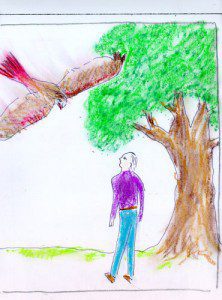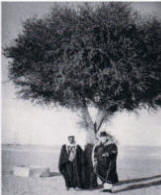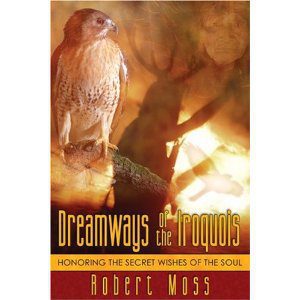 When I moved in the mid-1980s to a farm in upstate New York, in order to get away from the clutter of big cities, I was called to learn a new language. It started with a red-tailed hawk who turned up day after day as I walked the property.
When I moved in the mid-1980s to a farm in upstate New York, in order to get away from the clutter of big cities, I was called to learn a new language. It started with a red-tailed hawk who turned up day after day as I walked the property.
Sometimes, the hawk circled low over my head, and spoke to me insistently in a language I felt I could understand – if only I could speak hawk.
One night, in the twilight zone between waking and sleep, I found myself lifting out of my body and flying north above Lake George and Lake Chaplain, towards Canada, as if the hawk had lent me her wings. In my lucid dream I was drawn to a cabin in the woods, somewhere near Montreal, where an elderly Native woman spoke to me in a musical, cadenced language, more foreign to me than the voice of the hawk. In subsequent dreams I learned she was a respected healer, and I met other dream characters who seemed connected to her.
These dream people were clearly not of my own time. Their stories seemed to link historically to the first contact between Europeans and the First Peoples of northeast America, and though they spoke a language I did not know, they spoke as if I should understand them.
Dreaming in foreign languages was not new for me. As a child in Australia, I had learned to keep French and Greek dictionaries by my bed, since I dreamed so often in those languages. And my dreams still teach me phrases from the languages of the people I am visiting around the world – frequently before I get off the plane. This time, however, I had not been seeking contact with Native Americans, and I knew precious little about their traditions, so I was puzzled.
So I wrote down bits and pieces of their conversations phonetically, and looked for deciphering help in the ordinary world. Iroquois contacts suggested that I was dreaming in an archaic form of the Mohawk language of three hundred years ago, laced with some Huron words.
Through a series of synchronicities, I met several Iroquois scholars, grandmothers, and elders who offered to help me. “We will give you our best words,” said Hazel Dean-John, a distinguished Seneca linguist. With her help and that of native Mohawk speakers I began to decode some of the phrases from my dreams.
My new Iroquois friends not only helped identify and translate many key words, but also gave insights into my dream encounters with the old woman – whom I began to call Aksotha, or ‘Grandmother’ in Mohawk. The Iroquois were traditionally a matriarchal society, and the old woman in my dreams proved to be a clan mother, an atetshents, or dream shaman, and an arendiwanen, or ‘woman of power.’ Among the Six Nations of the Longhouse, called Iroquois, it is the women who are most frequently the spontaneous seers, the most brilliant storytellers, and the custodians of the web of life. It was hinted that the old woman might have contacted me from the past through her dreams, perhaps looking for information about the future, in order to help her people. Iroquois grandmothers are seen as the ‘burdenstraps’ – those who carry the people – and the chiefs are ‘walking sticks’ – for the people to lean on.
When I first spoke of my dream encounters to an elder at Onondaga, he said matter-of-factly, “I guess you had some visits.” He counselled me to be careful when dealing with disincarnate spirits, and suggested it might be wise not to talk in public about the names and details of certain traditional rituals that had come to me in dreams, as “Some of our great ones stay close to the earth to watch over our people and to defend the earth itself. They might talk to you, even though you are an outsider, because you dream the way we used to dream. You dream strong.”
These experiences gave birth to my novels Fire Along the Sky, The Firekeeper and The Interpreter – set in the time of early contact between Europeans and the Iroquois – and later to Dreamways of the Iroquois, which contains an account of the shamanic dream practices of the Iroquois, a retelling of their sacred teaching stories, and some episodes from my personal odyssey on these trails. In my books I call the ancient clan mother Island Woman, a version of her Mohawk name.

